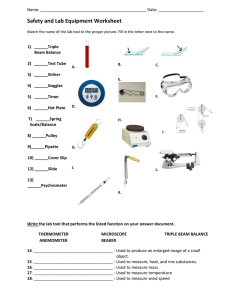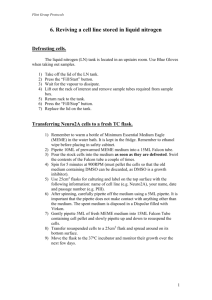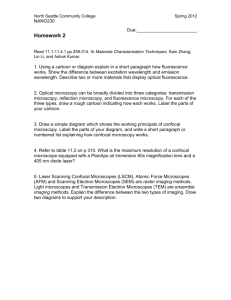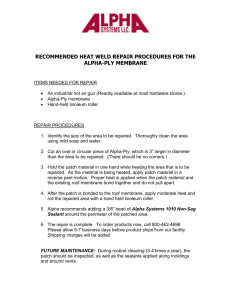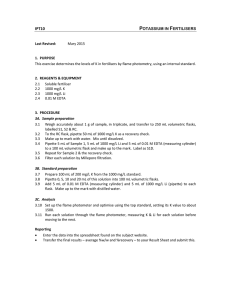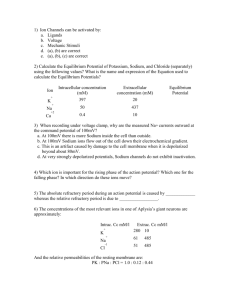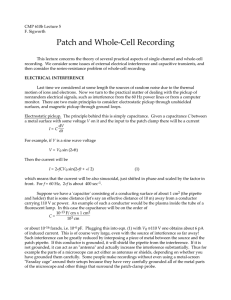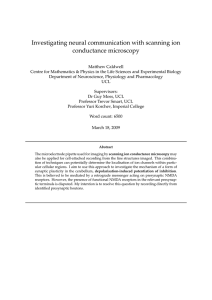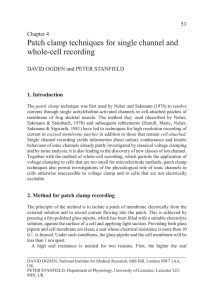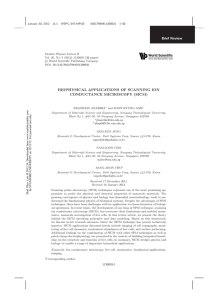“No, not the mind probe!” Matthew Caldwell , Simon Hughes
advertisement
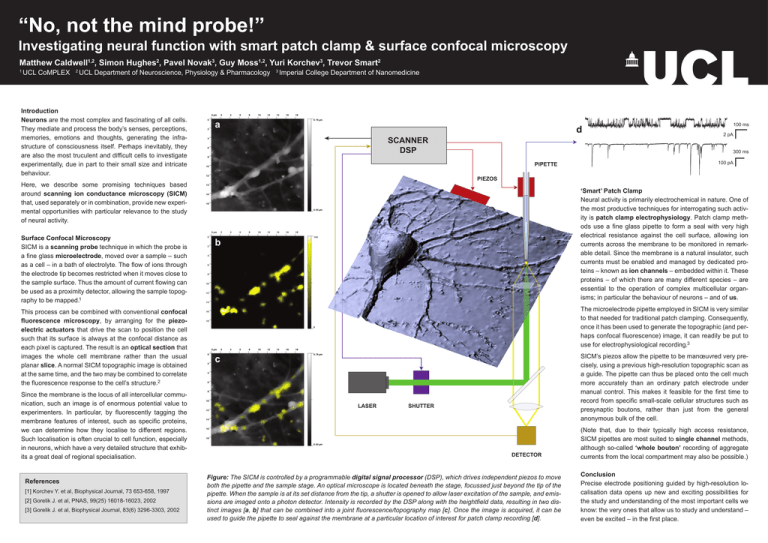
“No, not the mind probe!” Investigating neural function with smart patch clamp & surface confocal microscopy Matthew Caldwell1,2, Simon Hughes2, Pavel Novak3, Guy Moss1,2, Yuri Korchev3, Trevor Smart2 1 UCL CoMPLEX 2 UCL Department of Neuroscience, Physiology & Pharmacology Introduction Neurons are the most complex and fascinating of all cells. They mediate and process the body’s senses, perceptions, memories, emotions and thoughts, generating the infrastructure of consciousness itself. Perhaps inevitably, they are also the most truculent and difficult cells to investigate experimentally, due in part to their small size and intricate behaviour. 3 Imperial College Department of Nanomedicine a d SCANNER DSP This process can be combined with conventional confocal fluorescence microscopy, by arranging for the piezoelectric actuators that drive the scan to position the cell such that its surface is always at the confocal distance as each pixel is captured. The result is an optical section that images the whole cell membrane rather than the usual planar slice. A normal SICM topographic image is obtained at the same time, and the two may be combined to correlate the fluorescence response to the cell’s structure.2 Since the membrane is the locus of all intercellular communication, such an image is of enormous potential value to experimenters. In particular, by fluorescently tagging the membrane features of interest, such as specific proteins, we can determine how they localise to different regions. Such localisation is often crucial to cell function, especially in neurons, which have a very detailed structure that exhibits a great deal of regional specialisation. References [1] Korchev Y. et al, Biophysical Journal, 73 653-658, 1997 [2] Gorelik J. et al, PNAS, 99(25) 16018-16023, 2002 [3] Gorelik J. et al, Biophysical Journal, 83(6) 3296-3303, 2002 2 pA 300 ms PIPETTE 100 pA PIEZOS Here, we describe some promising techniques based around scanning ion conductance microscopy (SICM) that, used separately or in combination, provide new experimental opportunities with particular relevance to the study of neural activity. Surface Confocal Microscopy SICM is a scanning probe technique in which the probe is a fine glass microelectrode, moved over a sample – such as a cell – in a bath of electrolyte. The flow of ions through the electrode tip becomes restricted when it moves close to the sample surface. Thus the amount of current flowing can be used as a proximity detector, allowing the sample topography to be mapped.1 100 ms ‘Smart’ Patch Clamp Neural activity is primarily electrochemical in nature. One of the most productive techniques for interrogating such activity is patch clamp electrophysiology. Patch clamp methods use a fine glass pipette to form a seal with very high electrical resistance against the cell surface, allowing ion currents across the membrane to be monitored in remarkable detail. Since the membrane is a natural insulator, such currents must be enabled and managed by dedicated proteins – known as ion channels – embedded within it. These proteins – of which there are many different species – are essential to the operation of complex multicellular organisms; in particular the behaviour of neurons – and of us. b The microelectrode pipette employed in SICM is very similar to that needed for traditional patch clamping. Consequently, once it has been used to generate the topographic (and perhaps confocal fluorescence) image, it can readily be put to use for electrophysiological recording.3 SICM’s piezos allow the pipette to be manœuvred very precisely, using a previous high-resolution topographic scan as a guide. The pipette can thus be placed onto the cell much more accurately than an ordinary patch electrode under manual control. This makes it feasible for the first time to record from specific small-scale cellular structures such as presynaptic boutons, rather than just from the general anonymous bulk of the cell. c LASER SHUTTER DETECTOR Figure: The SICM is controlled by a programmable digital signal processor (DSP), which drives independent piezos to move both the pipette and the sample stage. An optical microscope is located beneath the stage, focussed just beyond the tip of the pipette. When the sample is at its set distance from the tip, a shutter is opened to allow laser excitation of the sample, and emissions are imaged onto a photon detector. Intensity is recorded by the DSP along with the heightfield data, resulting in two distinct images [a, b] that can be combined into a joint fluorescence/topography map [c]. Once the image is acquired, it can be used to guide the pipette to seal against the membrane at a particular location of interest for patch clamp recording [d]. (Note that, due to their typically high access resistance, SICM pipettes are most suited to single channel methods, although so-called ‘whole bouton’ recording of aggregate currents from the local compartment may also be possible.) Conclusion Precise electrode positioning guided by high-resolution localisation data opens up new and exciting possibilities for the study and understanding of the most important cells we know: the very ones that allow us to study and understand – even be excited – in the first place.
